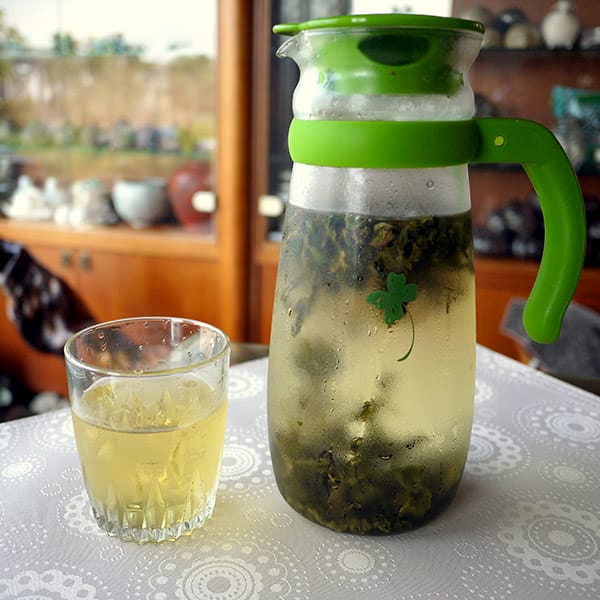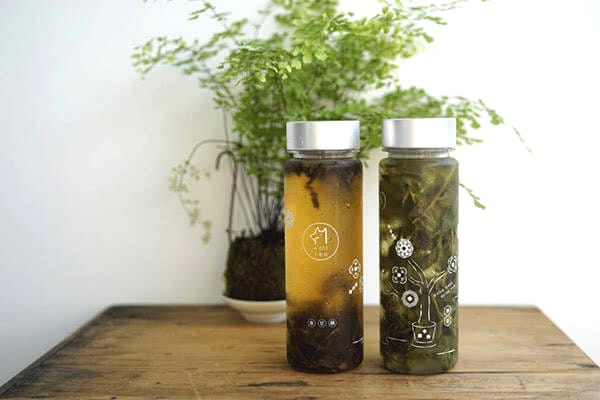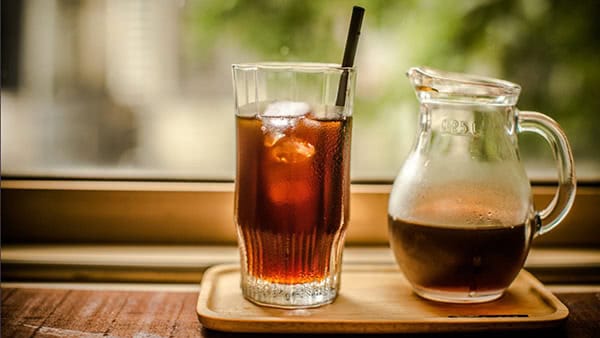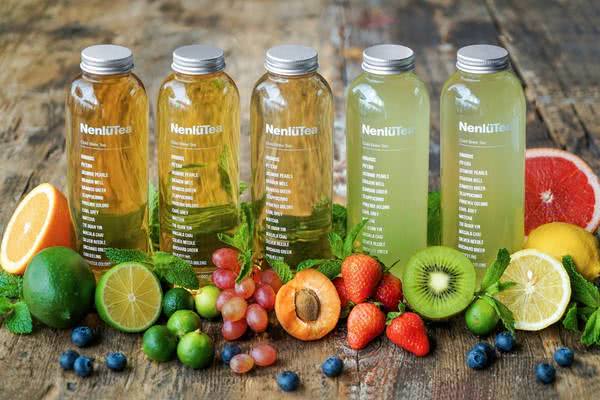Last Updated on 04/15/2020 by Desmond
Tea must be made by hot water steeping; this is almost a consensus in the past. However, now cold brew tea and iced tea are no longer regarded as a stupid things like ever. They have been popular for years, and you can find them in many beverage shop menus. For people who can’t stand the heat but love tea, it’s absolutely a great experience to have a cup of cold brew tea in the hot summer.
CONTENT
What Is Cold Brew Tea
The first thing we should figure out is that cold brew tea is different from iced tea.
Iced tea is made from hot tea cold down by ice cubes or other ways; it still needs hot water preparation.
Cold brew tea is directly prepared with cold water. You need to put the leaves or a tea bag in a jar, fill in bottled water, or cool down hot water, then put it into the fridge for a few hours(typically overnight,) waiting for the flavor in leaves to release slowly and become infusion.
Cold Brew Tea Vs. Hot Tea
Just like you can make up many delicious dishes with eggs in different cooking ways, there are also many differences between cold brew tea and hot tea.
Prepare Difficulty
Cold brew tea is no doubt easier than hot tea in preparation. Although it takes more time, you are no longer worried about failure due to the water temperature control, teaware chosen and steeping time. If you want to have cold brew tea at any time, you can prepare it half a day in advance; they can wait in the fridge long, about 48 hours.
Aroma
Aroma is an essential part of flavor to most teas. Typically we will feel the tea’s aroma from two aspects: the smell and the infusion.
The aroma components in leaves will release soon after heat by hot water. A part will dissolve in the water, and the other part will run into the air by the molecules’ thermal motion.
In the Chinese Traditional Tea Ceremony, there is a step for appreciating the tea aroma, with a special teaware called smelling cup help. Besides, Gaiwan‘s cover is often in an arched design to focus the scent for a better experience.
The aroma components dissolved in the infusion will fill the oral after you sip the tea down; that’s what we often call after-taste. It is delicate and lasts long.
Due to the cold brew tea being made with cold water, the aroma components of leaves are only dissolved in water(just a tiny part). Still, they can’t run into the air by the molecule’s thermal motion. To be honest, cold brew tea has a worse experience than hot tea on the aroma.
Flavor
Cold brew tea tastes very different from hot tea; even they are made with the same leaves.
The tea flavor releases faster if brewing with hot water. So hot tea usually tastes strong and with a robust aroma.
Brewing tea with cold water, the flavor releases slower. The amino acid, which brings sweetness, will come first. And the flavonoids and caffeine, which bring the bitter taste, will release slower. So cold brew tea usually tastes more weak, delicate, and sweet than hot tea, and without any bitterness and astringency.
As for which one tastes better? It totally depends on personal taste preferences, I think.
Benefits
As a healthy beverage, many people drink tea for its benefits. We know that tea’s benefits are primarily from a flavonoid called tea polyphenol; the familiar EGCG is part of it.
The water temperature will be controlled at 70-95℃ in the traditional tea brewing method. In this way, the nutritional ingredients in leaves release faster. Still, some of them(like EGCG and polysaccharides) may also easily break by hyperthermy.
The content of every nutritional ingredient in cold brew tea increases slowly as the steeping time grows. They come out so fast in the first two hours and turn slow later. After 8 hours of steeping, the total count of nutritional ingredients will be higher than hot tea, except for the caffeine.
The above is just a theory. There are many factors that influence the nutritional ingredients extracted content, such as the leaves and water ratio, tea’s type, cold storing temperature, sealing state, etc. Personally, hot tea may be healthier because drinking too much cold beverage is not good for the stomach.
Typically, the caffeine content of cold brew tea probably has less than 30% of hot tea. Because caffeine and tannin in leaves release slowest in the low temperature. That is why cold brew tea tastes not bitter, and won’t make you insomnia. Of course, it also depends on your steeping time. (know more about the factors that influence caffeine content in tea)
What Tea Is Suitable For Cold Brewing And Not?
Most teas, including herbal teas, are suitable for cold brewing. However, some are still not suggested for making cold-brewed. I am not saying they will take some side effects, but hot brew can better get their value. Let’s see what tea is suitable for cold brewing and not.
Green Tea & White Tea
Low fermentation degree teas like green and white are very suitable for cold brewing. They hadn’t been too much processed and retain the most natural ingredients. Making cold brew tea with them can better get the fresh aroma and sweet taste.
To the tender and rolled-in-tight Japanese green tea, they are naturally suitable for brewing with water with a relatively low temperature. Their flavor primarily comes from the rich amino acid, which is the most first-release ingredient during cold brewing. Comparatively speaking, to cold brew Japanese green tea takes less time. Matcha is a particular case. It is powder, and you can even mix it with cold water then drink it directly.
Yellow Tea
Yellow tea can also be for cold brewing theoretically, but I won’t suggest you do that. The charm of yellow tea is the unique “sealing yellow” aroma; it’s like a ripe rice fragrance and needs to be fully extracted by hot water. If to brew yellow tea with cold water, the flavor may become strange. The most important is that yellow tea is rare, and it seems to be a waste for cold brewing.
Oolong Tea
Oolong is a common base tea of cold brew tea, especially the Qing-flavor type Tieguanyin. In the cold brewing way, it can generate a more delicate orchid aroma, tender like a poem, not give a so aggressive feeling like it is in a hot brew.
About the Strong-flavor type Oolong, there are some disputes on cold brewing it. Except for a deeper fermented, most of them have been baked by carbon and got a unique smoky flavor. However, during the baking, a protective film formed on the leaves’ surface. It’s hard to extract the natural flavor from the leaves by cold brewing. To cold-brew smoky Oolong, and you will just get an obvious smoky flavor but almost not tea taste. Interesting, many people love this taste too.
Black Tea
Black tea is very suitable for making cold brew tea, either the loose leaves or tea bags. Because black tea has been entirely fermented, brewing it with cold water has a more negligible effect on the flavor. Instead, the low temperature slows the caffeine and EGCG release, making the natural strong bitter taste lesser.
CTC black teas from India and Sri Lanka have tiny leaves, their flavor releases fast, even in cold water. And flavoured teas like Earl Grey have a full fruit aroma(bergamot) itself, taste excellent for cold brewing. Besides, various cold-brew special tea bags are sold on the market, which takes black tea as a base and with kinds of flavors.
Dark Tea
Dark tea is totally not suitable for making cold brew tea. Dark tea has been through piling during processing, fermenting with the microorganisms help. And in the long aging, these microorganisms keep transforming the leaves’ ingredients and create a unique flavor.
This flavor needs to be extracted with high-temperature water, even needs to keep cooking in boiling water. To brew dark tea with cold water, you can just get a cup with a strange earth taste. Besides, some other microorganisms may breed due to special processing and aging. Coldwater can’t kill them, and it may affect your health.
Herbal Teas
Herbal tea types are vast. Whether it is suitable for cold brewing depends on what kind of the herb is. Like Honeysuckle, a herb with strong medical effects is unsuitable for cold brewing. Also the cinnamon and Chinese wolfberry seed. If you brew them with cold water, they will taste strange and cannot fully get their benefits.
And the common herbs like rose tea and rosemary tea are suitable for cold brewing. They are mostly taken as blended ingredients to improve the flavor. When you are confused, I suggest taking a smell, seeing whether you can accept the fragrance.
How To Make Cold Brew Tea
- Prepare a jar with cover, cool-downed boil water or bottled water, tea;
- Put them into the jar at leaves to water 1:50 ratio(you can adjust the scale according to your taste.) Cover, put it into the fridge, and wait for more than 6 hours(try not over 48 hours);
- Filter out the leaves with an infuser after finishing cold brew, then enjoy;
Tips
- Loose leaves and tea bags are OK for making cold brew tea. Loose leaves release flavor better, especially the CTC black tea. The tea bag is hard to release flavor due to the pouch barrier. But the tea bag is the best choice if you are going out;
- Cold brew tea is also suitable to be taken as other beverages’ base. You can add some juice, sugar, honey, or other food in, try making out a charming flavored drink;
- Although cold brew tea won’t go bad as fast as hot tea, you’d better finish it ASAP;




